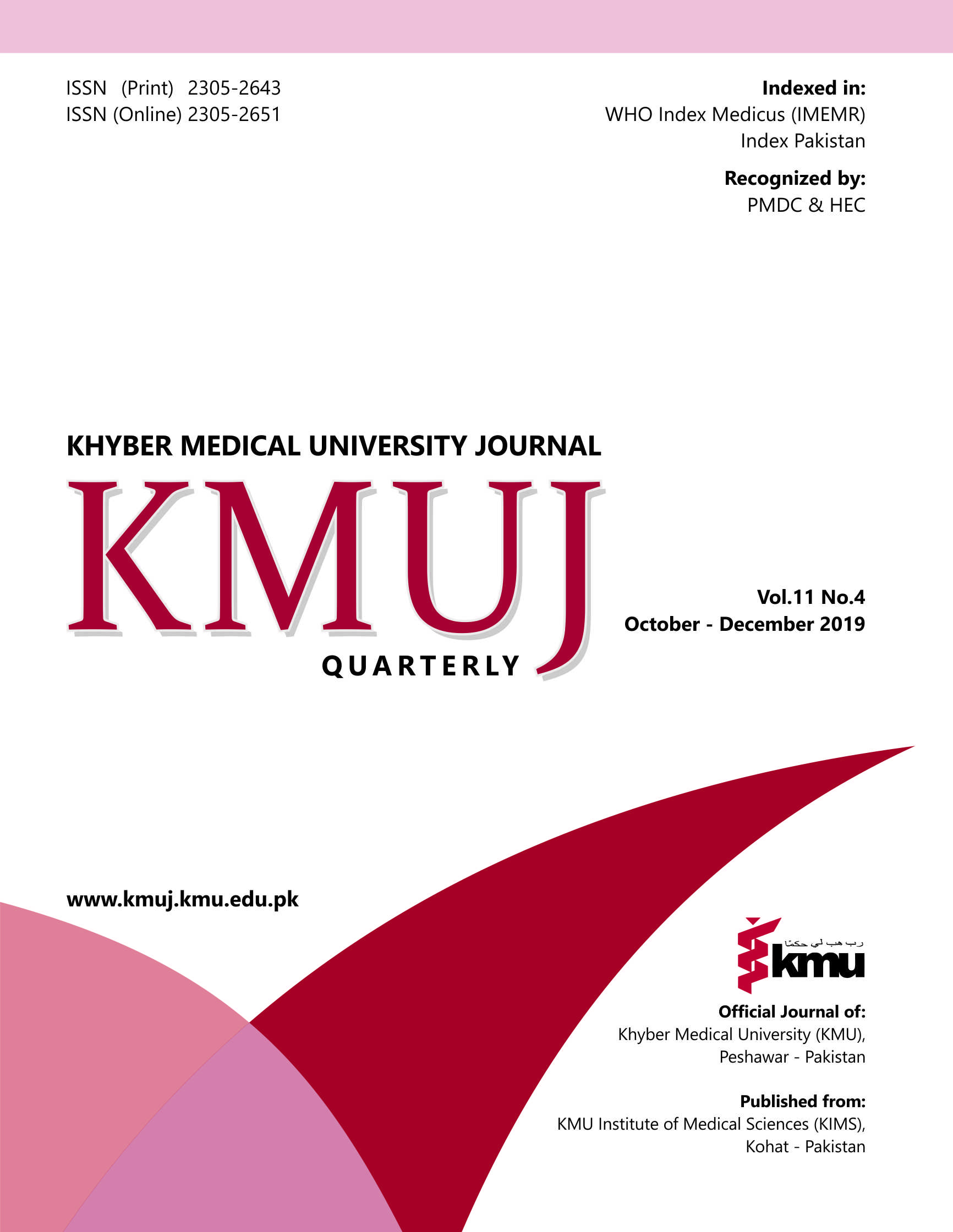KHYBER PAKHTUNKHWA INTEGRATED POPULATION HEALTH SURVEY (KP-IPHS) 2016-17
Main Article Content
Abstract
OBJECTIVES:To conduct a population-wide representative survey to collect multi-dimensional information on the various aspects of individual, household, and population health in the Khyber Pakhtunkhwa (KP) province of Pakistan.
METHODS:A multi-stage stratified cluster sampling is used in 24 districts of KP conducted from 2016-2017. Urban-areas are divided into enumeration blocks based on the low-, middle- and high-income groups and rural-areas are divided into mohallas/villages respectively. These are the primary sampling units (PSU’s). Each enumeration block/village/mohallas comrises of 250-300 households (secondary sampling units). Line listing of the selected enumeration blocks for urban and mohallas/villages for rural-areas are done to select 12 household per urban enumeration block and 16 households per rural PSU. The total sample size of the study is 15,724 households (3756 urban areas & 11968 rural areas). Three sets of questionnaires are used:
• A household questionnaire (consisting of demographic, and socioeconomic characteristics of all household members)
• A questionnaire for ever-married women aged 15-49 years (consisting of infant and maternal mortality, maternal and newborn health, contraception, child vaccination, and nutrition)
• A health questionnaire for adults aged ≥18 years (consisting of anthropometry, communicable and non-communicable diseases, stroke, disability, health-related quality of life, physical activity, dietary recall, tobacco use, environmental health, and medicine used).
Ethical approval has been taken from the ethical committee of the Khyber Medical University, Peshawar. The data will be entered and analysed in STATA version-14.
DISCUSSION:The outcomes of the survey could be used as an evidence to bring reforms in the health and population welfare policies.
Article Details
Work published in KMUJ is licensed under a
Creative Commons Attribution 4.0 License
Authors are permitted and encouraged to post their work online (e.g., in institutional repositories or on their website) prior to and during the submission process, as it can lead to productive exchanges, as well as earlier and greater citation of published work.
(e.g., in institutional repositories or on their website) prior to and during the submission process, as it can lead to productive exchanges, as well as earlier and greater citation of published work.
References
Mensah E, Goderre JL. Data Sources and Data Tools. In: Magnuson JA, Fu JrPC, editors. Public Health Informatics and Information Systems. 2nd ed. London: Springer-Verlag; 2014. p. 120.
Glynn MK, Backer LC. Collecting Public Health Surveillance Data. In: Lee LM, Teutsch SM, Thacker SB, St.Louis ME, editors. Principles and Practice of Public Health Surveillance. New York: Oxford University Press; 2010. p. 44-64.
Thacker SB, Wetterhall SF. Data Sources for Public Health. In: Stroupe DF, Teutsch SM, editors. Statistics in Public Health: Quantitative Approaches to Public Health Problems. New York: Oxford University Press; 1998. p. 39-58.
World Health Organization. Health Information System: Pakistan. WHO 2016 [Cited on: December 01, 2016]. Available from: URL: http://www.emro.who.int/pak/programmes/health-managment-information-system.html
Centers for Disease Control and Prevention. State, Tribal, Local & Territorial Public Health Professionals Gateway: Accreditation & Performance; Data & Benchmarks. CDC 2015 November 9. [Cited on: November 30, 2016]. Available from URL: https://www.cdc.gov/stltpublichealth/cha/data.html
Gupta N, Zurn P, Diallo K, Dal Poz MR. Uses of population census data for monitoring geographical imbalance in the health workforce: snapshots from three developing countries. Int J Equity Health 2003 Dec 29;2(1):11. DOI: 10.1186/1475-9276-2-11
Baffour B, King T, Valente P. The Modern Census: Evolution, Examples and Evaluation. Int Stat Rev 2013;81(3):407-25. DOI: 10.1111/insr.12036
Treasury Committee of the House of Commons British Parliament. Counting the Population. Volume 1. London: The Stationary Office; 2008 May 23. Report No.: HCP 183-1, session 2007-08, ISBN 9780215520593.
The Editors Encyclopedia Britannica. Census. Encyclopedia Britannica 2008 September 7 [Cited on: November 30, 2016]. Available from: URL: https://www.britannica.com/science/census
Canadian Public Health Association. The Impact of Cancelling the Mandatory Long-Form Census on Health, Health Equity and Public Health. Canada: CPHA-ACSP; 2010 Oct 18.
Jamal H, Khan AJ. Trends in Regional Human Development Indices. Social Policy and Development Center, Karachi, Pakistan; 2007. Report No.: 73. p. 5. [Cited on: November 30, 2016]. Available from URL: http://www.spdc.org.pk/Data/Publication/PDF/RR-73.pdf
Bureau of Statistics Khyber Pakhtunkhwa. Important District-wise Socio-Economic Indicators of Khyber Pakhtunkhwa for 2017. Bureau of Statistics, KPK 2017. [Cited on: November 30, 2016]. Available from URL: http://www.pndkp.gov.pk/wp-content/uploads/2017/07/DEVELOPMENT-STATISTICS-OF-KHYBER-PAKHTUNKHWA-2017.pdf
Sathar ZA, Wazir MA, Sadiq M. Prioritizing family planning for achieving provincial maternal child health and development goals. Islamabad: Population Council; 2014. [Cited on: November 30, 2016]. Available from URL: https://www.popcouncil.org/uploads/pdfs/2014RH_PrioritizingFP_RAF-Report.pdf
National Institute of Population Studies (NIPS) [Pakistan] and ICF International. Pakistan Demographic and Health Survey: 2012-13. Islamabad, Pakistan, and Calverton, Maryland, USA: NIPS and ICF International; 2013. [Cited on: November 30, 2016]. Available from URL: https://www.nips.org.pk/abstract_files/PDHS%20Final%20Report%20as%20of%20Jan%2022-2014.pdf
Bureau of Diplomatic Security United States. Pakistan 2016 Crime & Safety Report: Peshawar. Overseas Security Advisory Council USA 2016 [Cited on: December 2, 2016]. Available from: URL: https://www.osac.gov/pages/ContentReportDetails.aspx?cid=19396
Taspinar O. Fighting Radicalism, not 'Terrorism': Root Causes of an International Actor Redefined. Brookings Institution Washington USA 2009 [Cited on: December 2, 2016]. Available from: URL: https://www.brookings.edu/wp content/uploads/2016/06/summer_fall_radicalism_taspinar.pdf
Montazeri A, Harirchi AM, Shariati M, Garmaroudi G, Ebadi M, Fateh A. The 12-item General Health Questionnaire (GHQ-12): translation and validation study of the Iranian version. Health Qual Life Outcomes 2003 Nov 13;1:66. DOI: 10.1186/1477-7525-1-66.
Jeyagurunathan A, Sagayadevan V, Abdin E, Zhang Y, Chang S, Shafie S et al. Psychological status and quality of life among primary caregivers of individuals with mental illness: a hospital based study. Health Qual Life Outcomes 2017;15(1):106. DOI: 10.1186/s12955-017-0676-y
Huo T, Guo Yi, Shenkman El, Muller K. Assessing the reliability of the short form 12 (SF-12) health survey in adults with mental health conditions: a report from the wellness incentive and navigation (WIN) study. Health Qual Life Outcomes 2018;16(1):34. DOI: 10.1186/s12955-018-0858-2
Ali BS, Reza H, Khan MM, Jehan I. Development of An Indigenous Screening Instrument in Pakistan: The Aga Khan University Anxiety and Depression Scale. J Pak Med Assoc 1998;48(9):261-5.
Kothari R, Hall K, Brott T, Broderick J. Early stroke recognition: developing an out-of-hospital NIH Stroke Scale. Academic emergency medicine: official journal of the Society for Academic Emergency Medicine. 1997;4(10):986-90.
